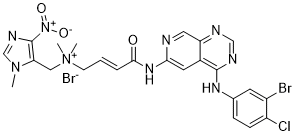All AbMole products are for research use only, cannot be used for human consumption.

Tarloxotinib bromide (TH-4000) is an irreversible EGFR/HER2 inhibitor. Tarloxotinib has the potential to effectively shut down aberrant EGFR signaling in a tumor-selective manner, thus potentially avoiding or reducing the systemic side effects associated with currently available EGFR tyrosine kinase inhibitors.
| Molecular Weight | 681.77 |
| Formula | C24H24Br2ClN9O3 |
| CAS Number | 1636180-98-7 |
| Solubility (25°C) | DMSO ≥ 28 mg/mL |
| Storage |
Powder -20°C 3 years ; 4°C 2 years In solvent -80°C 6 months ; -20°C 1 month |
[3] Ahmed Salem, et al. Targeting Hypoxia to Improve Non-Small Cell Lung Cancer Outcome
| Related EGFR/HER2 Products |
|---|
| Sevabertinib
Sevabertinib is an epidermal growth factor receptor (EGFR) tyrosine kinase inhibitor with antitumor activity. |
| BPIQ-I
BPIQ-I (PD 159121) is a potent and ATP-competitive EGFR tyrosine kinase inhibitor.. |
| HKI-357
HKI-357 is an irreversible dual inhibitor of EGFR and ERBB2 with IC50s of 34 nM and 33 nM, respectively. |
| SJF-1528
SJF-1528 is a potent EGFR PROTAC degrader with DC50 values of 39.2 nM and 736.2 nM for wild-type EGFR in OVCAR8 cells and Exon 20 Ins mutated EGFR in HeLa cells. |
| CH7233163
CH7233163 is a noncovalent ATP-competitive inhibitor for EGFR-Del19/T790M/C797S. |
All AbMole products are for research use only, cannot be used for human consumption or veterinary use. We do not provide products or services to individuals. Please comply with the intended use and do not use AbMole products for any other purpose.


Products are for research use only. Not for human use. We do not sell to patients.
© Copyright 2010-2024 AbMole BioScience. All Rights Reserved.
